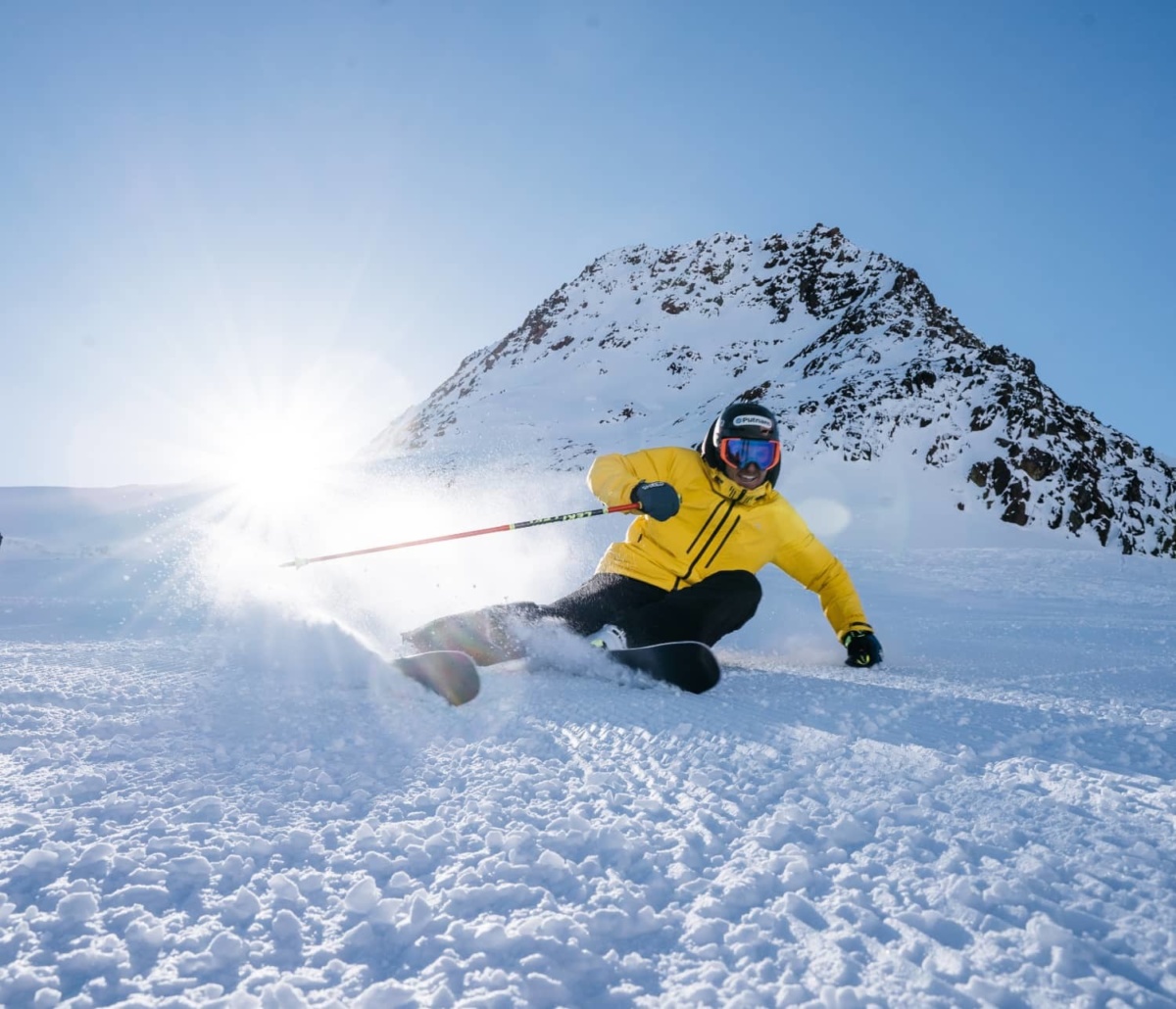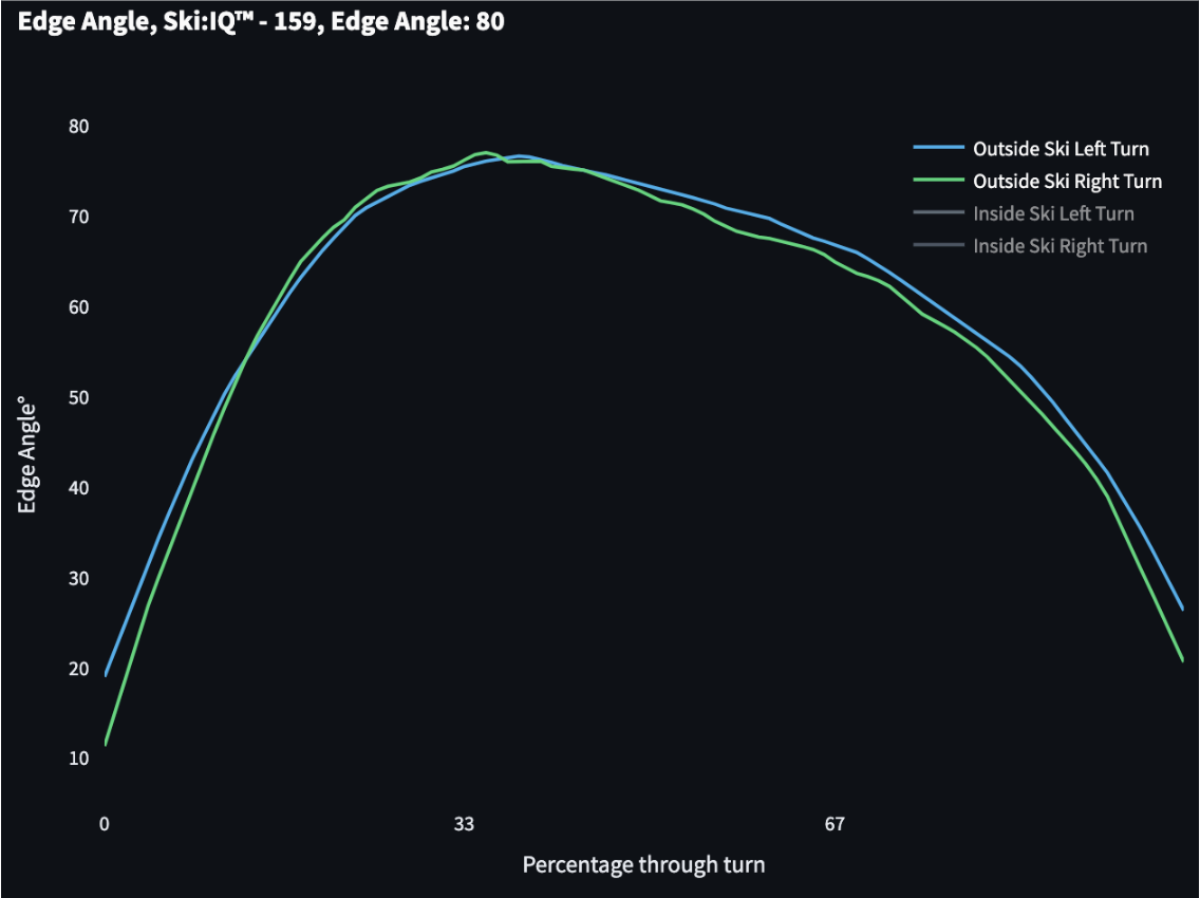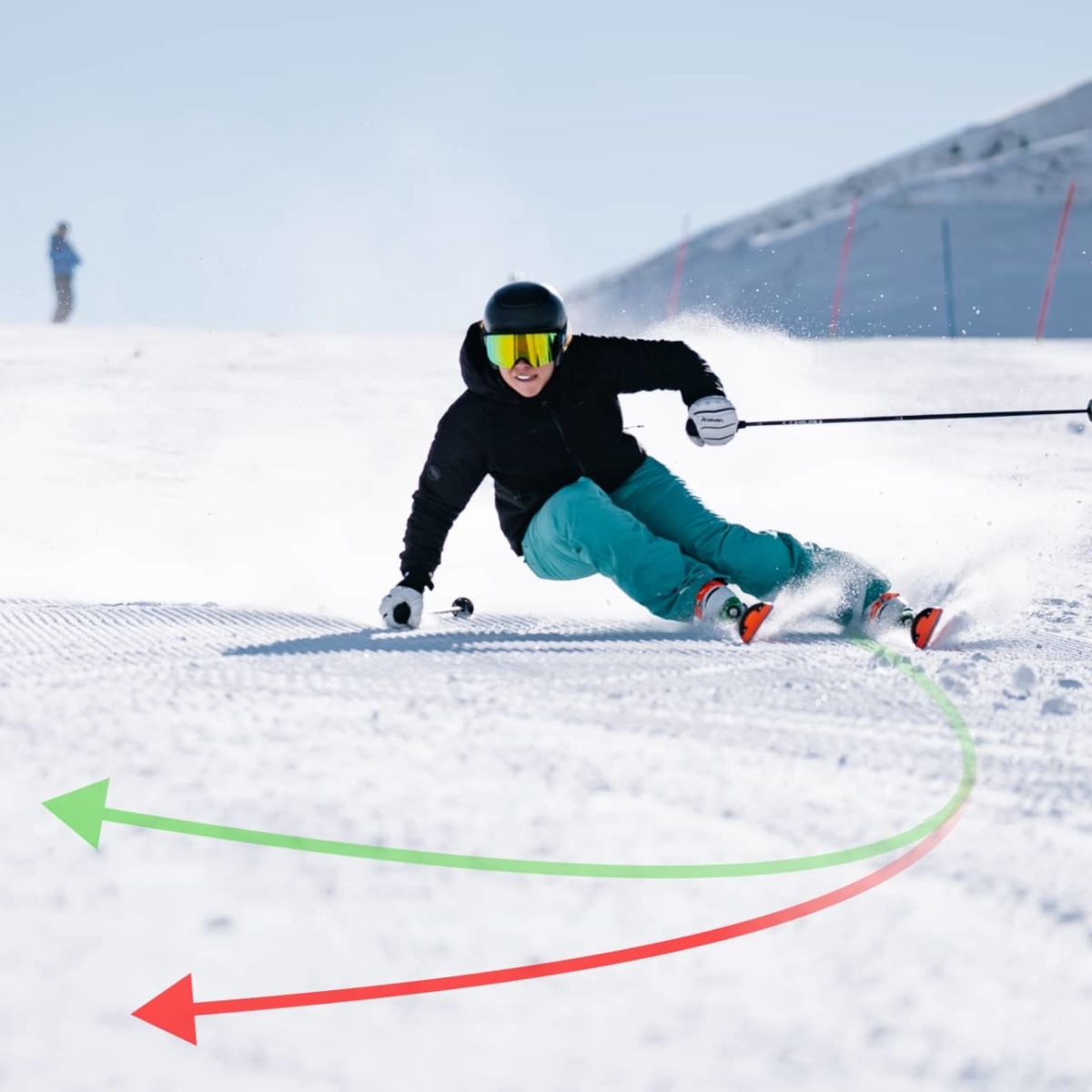
Votes:
Do you want to be that skier who turns heads as they tear up the run under the chairlift - all while making it look stylish and easy?
Do you want to keep your form together when you get onto steeper terrain?
Mid-Turn Edge Build might sound pretty technical, but it's a building block of all good carving and it’s the answer to the two questions above. By working on this new metric you’ll see your Ski:IQ sky-rocket, and probably your endorphins as well!
Behind the scenes at Carv HQ
We’re in a unique position at Carv, having collected the largest technique dataset in skiing. We’ve spent the last seven years recording turn data from skiers of every level, in almost every country across the globe. Our data gives us a platform to understand and measure parts of skiing that we’ve only been able to guess at until now. That’s important because getting objective feedback on your skiing is one of the most powerful tools to help you improve.
With that in mind, we spent our summer working with Ted Ligety, 5x world champion racer to understand if there are the hallmarks of high-performance skiing that Carv wasn’t currently measuring.
When you think about high-performance skiers, it’s not what happens on green runs that separates them out. An advanced skier and a pro can both make good turns on gentle terrain - but the difference between the two levels becomes really obvious when things get steeper.
An expert skier can make a tight radius turn on a steep, icy run, keeping their form, and managing their speed - while still looking good. An advanced or intermediate skier often struggles to do this, ending up going faster and faster each turn and having to brake or straight-line it until the bottom.
You’ll know if this is you because when things get steeper you find you just accelerate. You might even wonder how is it possible to still carve well and manage your speed?
We wanted to look at why this happens. Skiers like Ted create a tight radius turn on steeps by holding and even increasing their edge angle as the turn progresses. This means they are always directing their momentum sideways across the hill, rather than down the hill. A short radius turn creates beautiful arcs on steeper terrain, whereas a long radius turn will leave you pointing down the fall-line for longer - picking up speed.

This is usually why an advanced or intermediate skier can only make carving turns on mellow groomers.
Given that this skill is such an important difference between intermediate and expert skiers, we wanted to turn it into a metric that any Carv skier could measure.
Luckily we have all the right ingredients. Carv is excellent at assessing edge angle over the duration of your turn, so we could look at what % of your turn you are close to your maximum edge angle.
We called this metric: Mid-Turn Edge Build.
If you’re like Ted, you can keep increasing this angle for most of your turn - creating a very rounded turn with lots of progressive edge.
Now you can track it. And if you can track it, you can improve it.

So what is Mid-Turn Edge Build? As you can see above, Ted’s edge angle starts early in the turn, it is sustained throughout the apex (the midpoint), and remains extremely high up to ¾ of the way through the turn, only releasing very shortly before the transition into the new turn. By progressing his edge engagement throughout the turn he can make a very rounded, clean arc in the snow.
With Mid-Turn Edge Build, the skier is required to maintain and increase their steering effort through the turn to expertly counteract the forces at play.
This metric was extremely highly correlated with Ski:IQ - which means it’s something that we are likely already seeing in expert skiers.
Thanks to the hard work of our data scientists Sam and Charlie, this new metric is coming to a Carv app near you with the release of Ski:IQ™ Hintertux later this season.
Consistently scoring highly in Mid-Turn Edge Build, especially across steep and variable terrain, is a mark of confident, stylish skiing. So, if you want to turn heads on snow, then this is a great target you can focus on.
Let's get technical
Mid-Turn Edge Build is measured by mapping the median edge angle from 10 to 80 percent of the way through the turn arc.
To explain it better, I am going to show you examples of Carv’s raw data output.
These are average turn graphs - they show the data output of all the turns in a segment for a given metric, averaged together. Think of it like a fingerprint of your skiing.
We like to use them when we create metrics because they allow us to visualize what is happening for a given skier.
In this case, we are looking at edge angle - the roll of the ski as the turn progresses. (Nb. this doesn’t take into account slope gradient change. This is a very key point in why we don't see the edge angle progressing in Ted's data, while we can see from the video of Ted that it is progressing. This is the reason why we measure if the roll angle is sustained, while to achieve that in practice you must be increasing your edge angle.).
On the X axis, we have the ‘progression through the turn’ with 0 being initiation and 100 being completion. This is a one-turn window, but all the turns are averaged together.
On the Y-axis is the edge angle. A higher edge angle means the skier is at a greater angle.
In the first example, we have a very high-level skier (Ski:IQ 158).
In their data we can see that, they rise onto a very high edge angle (78 degrees) early in the turn window (about 30% of the way through the turn) (great early edging by the way). However, they quickly come off that high angle, they cannot sustain it and their ski flattens. On snow, this would look like a high edge angle, long radius turn, but still with a nice initiation.
By doing this they are going to be creating a higher speed, less rounded turn.

Now let’s look at another skier - with IQ 159. They still get onto their max edge at 30% through the turn, but they sustain near that max for a lot longer - until about 67% through. This is what their roll angle (angle compared to the horizon) does, their edge angle (angle compared to the slope) must be increasing to achieve this.
By increasing their edge angle high, they are going to be making a much more rounded arc, and a tighter radius turn. In doing so they are directing their momentum across the hill, into their next turn.

We’ve chosen these two skiers because they both get to a 78-degree edge angle (very high) at 30% of the turn (very early) - but the main difference is ‘progressive edge’ - i.e. for the second skier, you can see that the edge angle that we measure is sustained which means in practice, their edge angle must have been increasing throughout the turn - creating a very rounded arc and a tighter radius turn.
Tighter turns have higher forces and are more difficult to do, requiring the skier to test their skills in pressure and balance
Edge build happens in tandem with perfectly controlled pressure - gradually ‘pedaling’ through the outside ski, rather than overloading it with weight all at once. High Mid-Turn Edge Build scores then are a real test of discipline, and can’t be achieved by over-committing early, which will likely hinder balance and overall control.
So, how can you score well for Mid-Turn Edge Build?
To think about the effect Mid-Turn Edge Build has on top-tier skiing, it might be helpful to visualize how a truly good turn looks. The tracks we leave in the snow are often a tell-all about the execution of our technique. The CSIA skills framework explains ‘If the turning effort is not maintained, the turn shape will elongate (radius will increase)’. In other words, without Mid-Turn Edge Build our tracks will look less rounded, betraying a less skillful level of carving. My old ski coach used to draw a zigzag and a snake in the snow to demonstrate the difference between the lower effort ‘Z turn’ and the more desirable 'S turn’.

This shot highlights the distinction between a carved turn, and a “Park and Ride” turn - in which the skier simply rides out the turn on an edge angle they are comfortable with. ‘Parking’ on an edge, however high the angle, results in a longer turn radius turn and less dynamic turn technique.
We’ve learned that to shred like Ted we have to be more active in our technique, and with Mid-Turn Edge Build we’re finally able to objectively measure this dynamic movement, in real time. For many advanced skiers, this will help break through the dreaded Ski:IQ plateau. Just getting on edge is only half the battle, making a dynamic, right radius arc is the other half.
In last year’s iteration of Carv we were using the metric of Edge Smoothness to differentiate those who simply jerk onto a nail-biting edge momentarily, from those who can hold their nerve and their gravity-defying edge angle throughout their turn. The transition to Mid-Turn Edge Build in Ski:IQ™ Hintertux improves our ability to measure if a skier is really using their edges to drive their skis around the turn to completion.
What would Ted do?
In a perfect world, all metrics work together to facilitate the perfect turn. Edge Similarity is vital in resisting the counterforce, pulling your body back up and off of your edges, if your inside ski is not matching your outside ski angle, your knee is likely to push you up and out of the turn early. Ted says, “Having the Edge Similarity there is important to give your body the space needed to execute Mid-Turn Edge Build”.
Rotary separation and Early Forward Movement are equally as important to maintain technique and control when integrating with Mid-Turn Edge Build. Ted describes “having your center of mass continually moving down the fall line and inside the turn” whilst “still projecting your upper body down the hill, keeping your inside hand forward”. In my experience, a pole plant can help encourage this body position, especially in short turns, as it gets your weight and your inside shoulder moving down the fall line into the next turn.
So just as it is important to build edge angle early in your turn, it is also critical that edge angle is increased throughout, creating a rounded turn shape. Simply holding an edge can leave speed unchecked and will likely lead to a skidded turn, whereas building pressure and edge angle slowly on the outside ski will increase grip and control smoothly through the turn.
If you can master this skill, then you’ll be able to feel more confident on steeper slopes.
Transitioning to this type of turn - Ted’s Dos and Don’ts
Do start practicing on more intermediate terrain, before graduating this technique onto steeper slopes.
Do try to close your turn shape, making more completed turns across the piste.
Do think about holding onto that edge for longer, almost entering a traverse across the hill.
Don’t push the tails of your skis out. This will lead to a rushed, skidded turn.
Don’t let yourself rotate, keep your core strong and lead with the inside shoulder.
Don’t be impatient getting out of the turn; follow it through to completion.

Ski:IQ <110 For intermediate skiers, working at Mid-Turn Edge Build will come with achieving a higher edge angle, maintaining their steering effort by ‘pedaling’ pressure in the outside ski rather than skidding.
Ski: IQ between 115 and 130 For skiers climbing this section of the leaderboard, the turn breakdown will be a helpful indicator of Mid-Turn Edge Build, aiming for a higher percentage categorized as carving, as well as practicing their edge build with edge angle monitor mode. Ted Ligety’s ‘Train with Olympian’ mode will be an invaluable resource to skiers wanting to really progress, as well as the ‘Get Your Hip to the Floor’ training pack.
Ski: IQ >130 Advanced skiers should focus on the sensation of building their angle by rolling their toes and ankles in unison and tightening the turn for as long as possible. Aiming for high Mid-Turn Edge Build scores on steeper terrain will test their ability to follow through with a tight turn arc and really maximize edge angle in their beautiful snaking ‘S turns’.
Ski fitness training can really supplement the dynamic technique encouraged by Mid-Turn Edge Build. Check out Carv’s in-app fitness training videos to build strength, mobility, and balance off snow, which will translate into better ski days, higher scores, and hopefully less sore muscles!
Over to you
Carv is a product we can proudly say is built by skiers for skiers - we improve as you improve. We want to hear how you find your experience with Carv changes with this new algorithm, and how much Mid-Turn Edge Build impacts your improvement on the snow. Luckily we’ve got a well-connected community, on Facebook and across our platforms, and our team will be all ears for your feedback. So get out there and start improving your edging. Let us know how you find the new metric.